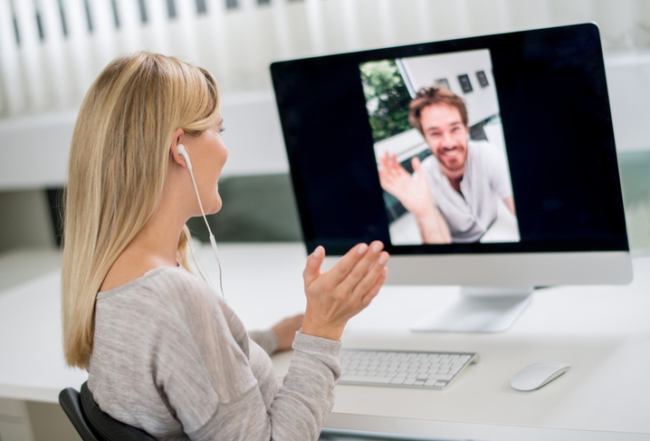You have /5 articles left.
Sign up for a free account or log in.

Istockphoto.com/andresr
As college students and faculty members face an onslaught of stressors related to the disruptions in their lives caused by the coronavirus pandemic, they are relying on each other for connection and coping strategies to help ease the weight of the public health crisis on their mental health.
While administrators and other employees are undoubtedly also affected by the dramatic departure of people from college and university campuses across the country, the upheaval has been most felt by students and faculty members who interacted more frequently and consistently -- and had more symbiotic relationships -- than others on campus.
Many students and faculty now find themselves functioning in unfamiliar terrain -- and struggling emotionally.
Colleges and universities are doing what they can to quickly shift counseling services for students from in-person therapy to telephone or video sessions. The technology is considered an effective replacement -- at least for now -- for the human connection that many students seek and need, and an important tool to lessen depressive symptoms, said Erica Riba, senior adviser for the Jed Foundation’s JED Campus program, one of the leading mental health and suicide prevention programs for colleges and universities, with about 300 member institutions.
She said some student feel a sense of loss after being told to leave their campus and return home to prevent the spread of coronavirus.
“There’s loss of identity -- ‘Who am I as a student, now that I’m trying to figure out what’s next and what all this means,’” Riba said. “This whole idea of social distancing is obviously important, but what we’re trying to point out is physically distancing. The social connection is very important right now.”
She said classes and coursework might be the only way students interact with each other while social distancing measures are in place, and she recommends that instructors look for ways to encourage students to share how the pandemic has impacted them, such as facilitating a discussion board.
This was one of the first ways Margaret Price, an English professor and director of disability studies at Ohio State University, gauged how her students were doing after the university ended in-person classes and announced it would move to online-only instruction.
Price said some instructors had suggested that the university conclude the semester early and give students a break, but she disagreed. Her special-topics English course, Rhetorics of Illness and Disability, is heavily discussion-based and very tight-knit; her students told Price they didn’t want to lose those connections amid “an avalanche of other losses” to their college experience over the last month.
“They already feel as though the world has shut down on them at an incredibly important part of their lives,” said Price, who has post-traumatic stress disorder. “A number of my students mentioned that they had paid so much for their education in financial cost and emotional sacrifices.”
Price assigned her English students to keep a private journal for the remainder of the semester and to post five excerpts from their journals that they’re comfortable sharing with the rest of the class. The assignment is part of a “mindfulness exercise” and asks students to be more aware of small details of their everyday life. She directed them to ponder such questions as: “Do you hear the birds differently? What do things smell like? What is your tactile environment indoors or outdoors?”
Faculty members who have been in touch with their students on a personal level can feel like they are “absorbing all their anxiety” and neglecting to focus on their own emotions and mental health needs, said Caroline Gottschalk Druschke, an English professor at the University of Wisconsin at Madison. With two young children at home and a partner who was just laid off from his job, Gottschalk Druschke said she feels overwhelmed with her family and work obligations. She has insomnia and gets most of her work done around 2 a.m., which is when she noticed many others in academe are also awake and active on Twitter.
“This is awful for everybody. It really is. I’m happy that I’m still employed and my employer is treating me well, but this is tough,” Gottschalk Druschke said. “People are putting in a really, really good-faith effort. I see the faculty around me, graduate students around me, really supporting each other and challenging each other to do better -- which means doing less.”
Aside from sharing thoughts and emotions with others, simple and fun interactions through social media and videoconferencing can also be meaningful for students, said Emily Lustig, a member of the advisory board for the Support Network, a peer support and advocacy organization for student mental health, which has chapters at seven major universities.
The networks have smaller groups that typically met in person on campus weekly, where members can talk about their mental health struggles, well-being or just “be heard,” Lustig said. Some students have continued these meetings virtually, while others have sustained the support system in more informal ways, such as virtual game nights and Netflix viewing parties, she said.
“Already having a foundation in place for understanding peer support, already having a weekly group, a groove with a group leader, figuring out how to share what’s going on in your life and learning how to listen to others is really important at this time,” Lustig said. “There’s a lot less trust building involved, and the structure for how it works implicitly is already in place.”
The Wolverine Support Network at the University of Michigan has held meetings to guide its group leaders for discussions with members about COVID-19-related anxiety, self-care and healthy family or roommate relationships for students in quarantine at their homes, said Hannah Connors, executive director of the network and a senior at Michigan. It was challenging to balance leading the support network on top of the “emotional pain, loss and confusion” that she was experiencing as a student, but Connors said she has been able to adjust over the last two weeks.
“People need support right now more than ever,” Connors said. “They need ways to connect with others and need community. We’ve found a way to make the best of this situation.”
But the peer-support networks are meant for listening and empathy, not for providing counseling services or advice, Lustig said. Demand for mental health services has not decreased at some colleges even though students aren't on campus. During a webinar on telehealth hosted by the American College Health Association last Friday, Jun Mitsumoto, associate medical director for primary care at New York University’s Student Health Center, described the significant level of need at his institution. He said of 952 telehealth appointments held on March 19, two-thirds were for mental health counseling.
College presidents are greatly concerned about the emotional impact the coronavirus pandemic will have on students and employees, according to an Inside Higher Ed and Hanover Research survey of 172 presidents published last week. Ninety-two percent of responding presidents said they were “very” or “somewhat” concerned about the mental health of students amid the pandemic, while 88 percent said the same of employee mental health. Nearly all student affairs officials surveyed by Inside Higher Ed before the virus made its way to the United States said they “have paid a significant amount of attention” in the last year to student mental health.
Many colleges and universities are looking to telehealth options to continue or initiate student appointments with counseling center therapists via telephone, or through online platforms such as Zoom for Healthcare and Doxy.me, which are popular with institutions that allow clinicians to meet virtually with patients, Riba said. For students with already-existing mental illnesses who have been using services, it’s important that they maintain their “supportive therapeutic relationship” with the same clinician they met with before the pandemic, Riba said.
“That would be the recommendation, but schools have to work with what they have,” Riba said. “I imagine it’s a little bit more infrequent, but people are trying their best and will check in by phone, even if it’s brief. Hopefully it’s a consistent basis of checking in and making sure that students are supported from afar.”
Videoconferencing platforms for counseling service delivery are “not easy to set up quickly from scratch,” Peter LeViness, director of counseling and psychological services at the University of Richmond and board member of the Association for University and College Counseling Center Directors, or AUCCCD, said in an email. According to the most recent survey of 571 counseling center directors, conducted by the AUCCCD in 2018, well before the coronavirus pandemic, only 11.3 percent conducted telephone counseling sessions, and 3.5 percent used video sessions.
In addition to implementing and training counseling center staff to use new technology and ensuring university malpractice insurance covers telehealth services, counseling centers also must wait for several state medical licensing boards to temporarily suspend requirements that prevent them from practicing over state lines, as many students who need appointments are out of state, LeViness wrote. He said the AUCCCD is asking federal legislators to step in.
“AUCCCD along with other national mental health-related organizations have requested the federal government to pass national legislation that would temporarily allow licensed mental health professionals to continue to provide therapy to students who are now residing in other states.”
Alex Azar, secretary of the U.S. Department of Health and Human Services, has asked states to relax these licensure laws, Mei Wa Kwong, executive director for the Center for Connected Health Policy, said during the ACHA webinar. The department’s Office for Civil Rights will temporarily waive penalties related to practicing telehealth that would normally violate the Health Insurance Portability and Accountability Act, or HIPAA, which protects patient health information, said a notice from HHS.
Telehealth models are “imperfect,” but “better than nothing,” said Lustig of the Support Network. The network’s board has debated the effectiveness of virtual counseling sessions and is still going back and forth about it, she said.
“The response right now is, truly, this is our only option,” Lustig said.







